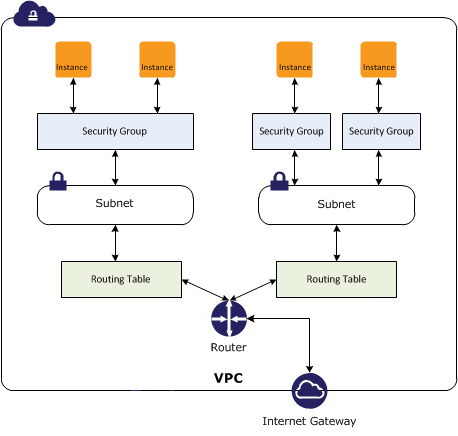Amazon AWS Security Concepts: Difference between revisions
No edit summary |
|||
| Line 78: | Line 78: | ||
[[Image:security_group.png|center]] | [[Image:security_group.png|center]] | ||
This is the procedure to create a security group | This is [[Amazon AWS Security Procedures#Create_a_Security_Group|the procedure to create a security group]] | ||
Revision as of 18:44, 11 February 2016
External
- Setting Up with Amazon EC2 http://docs.aws.amazon.com/AWSEC2/latest/UserGuide/get-set-up-for-amazon-ec2.html
Internal
AWS User
AWS services require that you provide credentials when you access them. The console requires your password. You can create access keys for your AWS account to access the command line interface or API. However, it is not recommended to access AWS using the credentials for your AWS account. Use IAM instead.
To create an AWS account, go to http://aws.amazon.com, and then click Sign Up.
For more details see http://docs.aws.amazon.com/AWSEC2/latest/UserGuide/get-set-up-for-amazon-ec2.html.
IAM (AWS Identity and Access Management)
- IAM Introduction: http://docs.aws.amazon.com/IAM/latest/UserGuide/introduction.html
- IAM Concepts http://docs.aws.amazon.com/IAM/latest/UserGuide/IAM_Concepts.html
AWS Identity and Access Management is a web service that enables Amazon Web Services (AWS) customers to manage users and user permissions in AWS. The service is targeted at organizations with multiple users or systems that use AWS products such as Amazon EC2, Amazon RDS, and the AWS Management Console. With IAM, you can centrally manage users, security credentials such as access keys, and permissions that control which AWS resources users can access.
Without IAM, organizations with multiple users and systems must either create multiple AWS accounts, each with its own billing and subscriptions to AWS products, or employees must all share the security credentials of a single AWS account. Also, without IAM, you have no control over the tasks a particular user or system can do and what AWS resources they might use.
IAM addresses this issue by enabling organizations to create multiple IAM users.
IAM User
An IAM user is a person, system, or application who can use AWS products, each with individual security credentials, all controlled by and billed to a single AWS account. With IAM, each user is allowed to do only what they need to do as part of the user's job.
TODO, continue with IAM concepts http://docs.aws.amazon.com/IAM/latest/UserGuide/IAM_Concepts.html
AWS root Account (ovidiu@novaordis.com)
|
+---- IAM Users
|
+-- ofeodorov
API Access Keys
Each IAM user has a set of API access keys. These keys are needed when the user attempts to make programmatic calls to AWS or EC2, using Amazon EC2 CLI tools for example. The user can create, modify, view and rotate these access keys.
There are two types of access keys:
- Access key ID (example AKIAIOSFODNN7EXAMPLE))
- Secret access key (example: wJalrXUtnFEMI/K7MDENG/bPxRfiCYEXAMPLEKEY)
When creating an access key, IAM returns the access key id and the secret access key. The secret access key is only accessible at the time it was created. If the secret access key is lost, the corresponding access key must be deleted and recreated.
Relationship between Access Key ID and Secret Key?
The access keys can be managed here: https://console.aws.amazon.com/iam/home?#security_credential by navigating to Users -> username -> Security Credentials -> Access Credentials.
More about access keys for IAM users: http://docs.aws.amazon.com/IAM/latest/UserGuide/ManagingCredentials.html
For details on how access keys can be set in the local environment, see Setting the Access Keys during Amazon EC2 CLI Installation.
MFA Multi Factor Authentication
Instance Access Key Pairs
Amazon AWS uses public-key cryptography to secure the login to instances. The instance has no password - you use a key pair to access your instance securely. The key pairs are provisioned either via the web interface or with Amazon CLI tools. During the provisioning process, the keys pairs are named. When the instance is created, you need to specify the name of the key pair to use to protect access to it: Amazon will install the public certificate in ~/.ssh/authorized_keys when creating the instance, and then you need to provide the private key of the pair to your ssh client when logging into the instance.
External reference: http://docs.aws.amazon.com/AWSEC2/latest/UserGuide/ec2-key-pairs.html
This is the procedure to create a key pair.
Security Group
- Amazon EC2 Security Groups for Linux Instances https://docs.aws.amazon.com/AWSEC2/latest/UserGuide/using-network-security.html
A security group acts as a virtual firewall for instances. The security group controls inbound and outbound traffic. You can specify one or more security groups when you launch an instance. A security group contains a set of rules that control the inbound traffic and a different set of rules that control the outbound traffic. All other traffic is discarded. The rules can be modify at any time; the new rules are automatically enforced.
